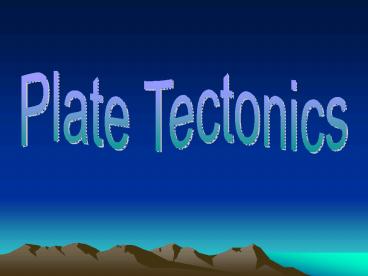Unit Six Notes PowerPoint PPT Presentation
Title: Unit Six Notes
1
Plate Tectonics
2
Warm-Up
- What evidence do we have that supports the idea
of one giant supercontinent (Pangaea)? Cite
evidence from Alfred Wegners findings. - What force is causing the Earths plates to move?
3
How is this possible?!?!?
4
(No Transcript)
5
Objective
- By the end of class you will.
- Be able to identify the three different types of
plate boundaries.
6
3 Types of Plate Boundaries
- Convergent
- Divergent
- Transform
7
- Convergent Boundary plates are moving toward
each other and are colliding (3 types)
8
When a continental plate collides with another
continental plate
- Mountain ranges are created
- (example Himalayan Mountains)
9
The Himalayas
10
When Oceanic Plates collide with Continental
Plates
- Create subduction zones or trenches
- Create near coast volcanoes
- Example Ring of Fire!
11
(No Transcript)
12
When ocean plates collide with other ocean plates
- Island arcs are created
- (a pattern of volcanic islands created from a
subduction zone that is located off the coast)
13
Aleutian Islands
14
Plate Boundaries
- Divergent boundary
- Plates are moving away from each other
15
Plate Boundaries
- Divergent boundary
16
Transform Fault Boundary
- Plates are neither moving toward nor away from
each other, they are moving past one another.
17
Transform Fault Boundary
- The plates may move in opposite directions or in
the same directions but at different rates and
frequent earthquakes are created! (example San
Andreas Fault)
18
San Andreas Fault
19
Lets Play Name That Boundary!
20
(No Transcript)
21
(No Transcript)
22
North American Plate
Pacific Plate
23
(No Transcript)
24
(No Transcript)
25
(No Transcript)
26
(No Transcript)
27
How can Oreos model the plate boundaries?
- Very carefully, take just the top cookie off the
Oreo. - Break the top cookie into 2 equal halves.
- Replace the cookie halves back on the Oreo
- Using the cookie,
- Demonstrate a transform fault boundary
- Demonstrate a divergent plate boundary
- Demonstrate a convergent plate boundary
28
Quiz Time!
PowerShow.com is a leading presentation sharing website. It has millions of presentations already uploaded and available with 1,000s more being uploaded by its users every day. Whatever your area of interest, here you’ll be able to find and view presentations you’ll love and possibly download. And, best of all, it is completely free and easy to use.
You might even have a presentation you’d like to share with others. If so, just upload it to PowerShow.com. We’ll convert it to an HTML5 slideshow that includes all the media types you’ve already added: audio, video, music, pictures, animations and transition effects. Then you can share it with your target audience as well as PowerShow.com’s millions of monthly visitors. And, again, it’s all free.
About the Developers
PowerShow.com is brought to you by CrystalGraphics, the award-winning developer and market-leading publisher of rich-media enhancement products for presentations. Our product offerings include millions of PowerPoint templates, diagrams, animated 3D characters and more.

